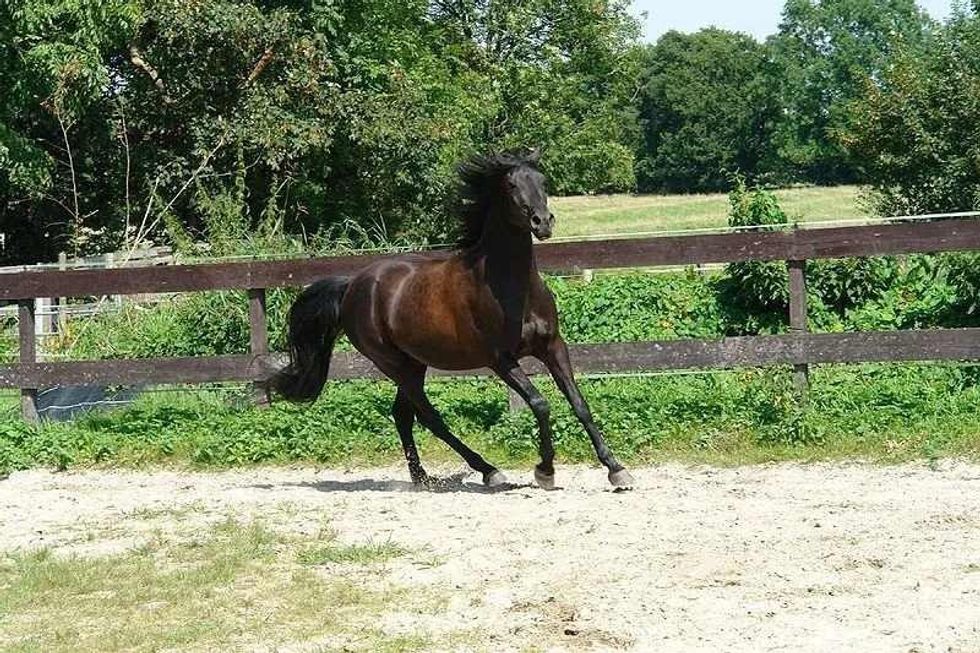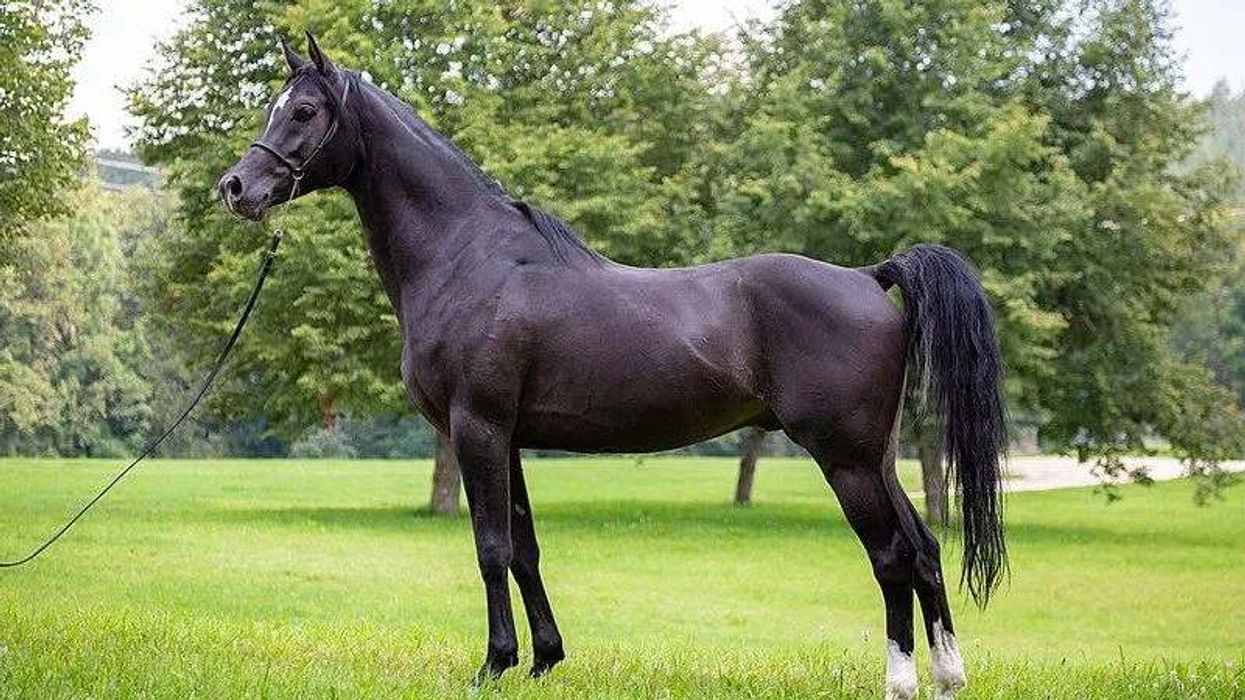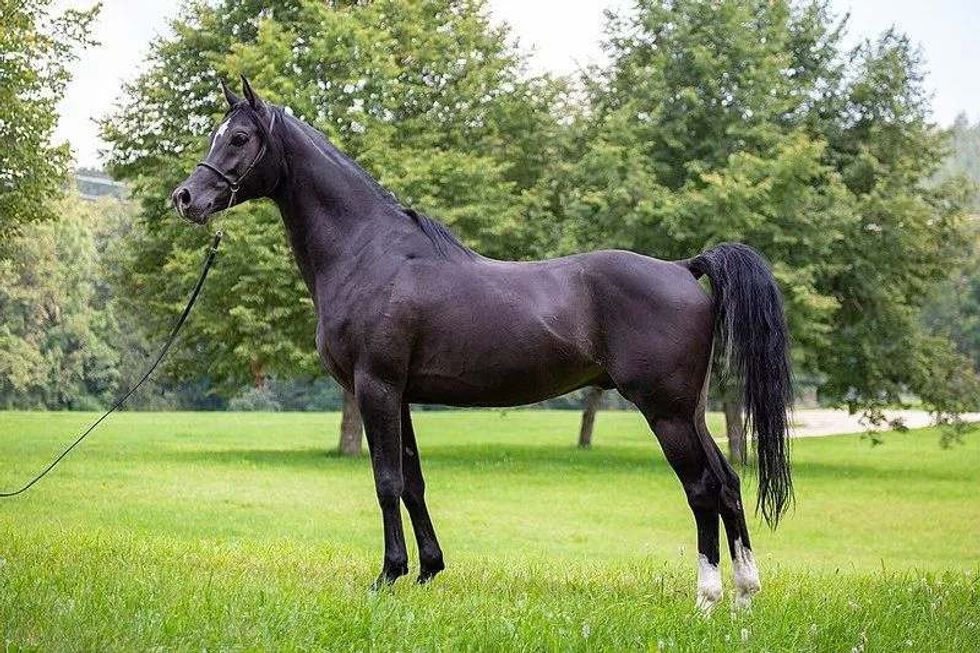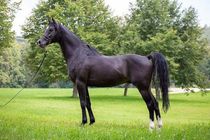Fun Arabian Horse Facts For Kids
An Arabian horse, also known as Arabian or Bedouin Arabian, is believed to have been bred by the ancient Bedouin tribes in the Arabian peninsula. The Arabian horse's origin is often disputed by historians, but there is recorded evidence of this breed coming into existence 2000-3500 years ago.
The beauty of Arabian stallions is legendary, but these Arabians are also celebrated for their refined characteristics. They are known to have a cooperative and easily trainable nature, a strong riding ability, and superlative endurance even in tough weather conditions and war-like situations.
This is not accidental, as the Bedouins developed this breed of horse exclusively to survive and thrive in the middle east desert.
With time, this breed has evolved to become the perfect, hardworking companion to humans. In fact, George Washington is famously believed to have ridden an Arabian horse called Blueskin during the American Revolutionary War. This is a testament to the exceptional traits of this fine breed of horse.
Today, Arabians are frequently listed among the top 10 popular breeds in North America. They are also bred by quality breeders in Asia (the middle east), Australia, and several parts of Europe.
Included in this article is information such as Arabian horse height, purebred Arabian horse history, Arabian horse genetic information, Arabian horse warhorse, Arabian horse's coat, head, arched neck, high tail, and short back features, and so on.
At Kidadl, you can explore many other fascinating types of animals by reading wild horse facts and paint horse facts.
Arabian Horse Interesting Facts
What type of animal is an Arabian horse?
It is a four-legged equine animal, much like a zebra.
What class of animal does an Arabian horse belong to?
It belongs to the Mammalia class.
How many Arabian horses are there in the world?
Experts estimate that Arabian horses presently have a population size of around 1 million individuals spread across their native Middle East region (Arabian peninsula), Australia, Europe, and North America. In a surprising twist, it is the United States and Canada that have the highest population numbers in this breed.
Where does an Arabian horse live?
An Arabian horse was bred by the ancient Bedouin tribes on Arab lands to survive in the desert region with its extreme weather conditions. This makes it possible for these horses to live in almost any location.
What is an Arabian horse's habitat?
The natural habitat of this breed mimics the desert climate, with dry and extreme weather conditions.
For this, many purebred Arabian horses have a slight bulge on their head, in their forehead region. This visual characteristic is also seen in a camel, another desert animal. The Arab Bedouins referred to it as Jibbah. They believed it enhanced the breathing ability and lung capacity of the animal, so it could survive in the desert.
All Arabian horses have dark black skin, regardless of their coat color. This further helps them acclimatize to very hot and very cold temperatures. They also have strong hoof walls, with the ability to walk with ease even on the slippery desert sand.
All these superior equine characteristics help this Arabian breed survive in almost any part of the world. This includes grasslands, on a ranch, and even in an urban setup. It is hence no surprise that their population is over one million, thriving in four continents, including Asia, Australia, Europe, and North America!
Who do Arabian horses live with?
They are a domesticated breed and can be part of a herd, living with other farm animals. They can also live by themselves under managed human care.
How long does an Arabian horse live?
They have an average lifespan of 25-30 years. This is typical of most horse breeds. But this prized breed seems to always offer something extra. It is thus unsurprising that the oldest recorded Arabian horse lived beyond 40 years!
How do they reproduce?
Arabian horses belong to a domestic breed. So their breeding and reproduction are managed by experienced breeders.
Also, the original breed was simply known as the 'Bedouin strain.' But modern classifications recognize six distinct bloodlines inherited from this strain. They are named based on the ancestry of the Arabian horses imported into the United States in the early '40s (1944 or before).
Arabians achieve sexual maturity before they turn one year old. The breeding schedule is dependent on the estrous cycle of mares in the spring-summer season. During this time, the mare becomes sexually receptive for about seven days within a three-week period. Breeders use this time frame for mating female Arabians with healthy stallions.
The gestation period for Arabians is 11 months. The heartbeat of the young fetus can be detected from the second month. From this time, the mare requires special care and supervision to ensure she does not inadvertently miscarry. She is often fed with vitamin supplements and given de-worming medication at times intervals (one or two times during gestation).
When the mare is due for birthing, she is separated from other horses in her herd for the safety of her foal. Arabians also have a blissfully short labor period (approximately 30 minutes).
Breeders encourage the new foal to begin nursing from the mother within the first hour of birthing. They continue to remain close and nurse until they are six months old.
What is their conservation status?
With over 1-million Arabian horses spread all over the world, the conservation status of this breed, according to the IUCN, is Not Extinct.
Arabian Horse Fun Facts
What do Arabian horses look like?

Arabians are marginally shorter and smaller than many horse breeds. But these are still strong equines, with the trademark horse face, an arched neck, a short back, and a high tail carriage.
They also have a noticeable bulge on their head, in their forehead region. They came in varied colors like black, gray, red, and chestnut. They all universally have black skin below their coat, especially if they are a purebred variety.
Arabians are also famous for their symmetric beauty. In fact, black stallions are Egyptian Arabians who often fetch the top prize and price in international horse shows.
How cute are they?
Like all horses, Arabians have their own brand of cuteness. They are resilient creatures and can be the perfect human companion even in tough conditions.
They have superior riding abilities and expect the same level of skill from their handlers. They are hardworking and have an amicable temperament at most times. But they are also famous for becoming 'hot-blooded', especially when they are misunderstood or mishandled by trainers.
If you want an elite breed that supports you but is also not afraid to challenge you, Arabians are the perfect horse breed for you!
How do they communicate?
Like all animals, Arabians use a combination of verbal and non-verbal cues to communicate. They also use body language to communicate with humans effectively.
For instance, Arabians showcase their restlessness when they wag their tails from side to side. When they are stressed or unhappy, their ears go back while their eyes are wide open. This is a cue to avoid riding the horse, as it can display aggressive behavior when it is out of ease.
Arabians are also unafraid to show love, nuzzling playfully to handlers when they are comfortable. An Arabian’s 'grin' is also a thing of beauty, as owners work hard to get rewarded by their Arabian with a winsome smile.
How big is an Arabian horse?
The Arabian horse stands tall at 57-61 in (144.8-154.9 cm) height and weighs a hefty 800-1000 lb (362.9-453.6 kg). This makes it comparable in size to a zebra.
The Arabian breed is also smaller than most other horse breeds. It is still considered a prized breed due to its superior traits, including its strength, endurance, and amicable temperament.
How fast can an Arabian horse move?
The average horse speed is 34.2 mph (55 kph). With its exceptional stamina and endurance, an Arabian horse can gallop at a speed of 40.4 mph (65 kph). This is yet another area where the Arabian horse breed leads from the front!
How much does an Arabian horse weigh?
The Arabian horse's weight ranges between 800-1000 lb (362.9-453.6 kg).
What are the male and female names of the species?
A male Arabian horse is called a stallion. Female Arabian horses are called mares.
What would you call a baby Arabian horse?
Baby Arabian horses are called foals. If the young one is a male, it is also called a colt. If it is female, it is called a filly.
What do they eat?
They are herbivorous animals and feed on a diet of grass, hay, grains, and oats. They may also be given fruits and vegetables in controlled quantities.
Are they dangerous?
Arabian horses are not particularly dangerous, as they are mild-mannered and trainable. But these intelligent animals also demand expertise and respect from their owners. In fact, they can even become 'hot-blooded' if they are not treated well by their handlers.
Would they make a good pet?
Yes, as the Arabian horse temperament is ideal for pet adoption. They are amicable and intelligent and can be safe companions for human families. They also have the stamina to perform strenuous tasks (like carrying heavy loads) and can go riding for long hours. So they thrive in a large farm or ranch setup.
But, they do demand respect and expertise from their handlers. In fact, this breed is also known to get 'hot-blooded', if they are not understood or mishandled by trainers.
Did you know...
Here's an interesting piece of Arabian horse history and mythology on this elite equine. Arabs believe that this top horse breed inherited exceptional qualities from its legendary ancestor, a purebred Arabian horse that was driven by Muhammad the prophet. They also believe that it was blessed with superpower-like abilities, including the ability to go riding for days without water.
How much does an Arabian horse cost?
The Arabian horse price ranges between $5,000 – $150,000 USD. At first glance, this may seem like an extravagant purchase, but horse lovers will recognize that this prized breed is more than worth its weight in gold!
Jokes aside, this breed commands a higher price than most other breeds due to its exceptional qualities. This includes its unique ability to survive in almost any environment, its intelligent response to training, its show-worthy frame, and the superior stamina that makes it a hardworking farm animal.
The Arabian horse cost is determined by several factors. This includes the age of the horse, the quality of the breed (purebred or half-bred), ancestry, color choice, availability within the buyer’s location, and conformation to breed standards. Regardless, a purebred black Arabian horse is often expected to command the highest price.
The Egyptian Arabian horse is also a contender for top dollar, as it is considered the purest Arabian horse breed, authentic to the original Bedouin strain. Other popular choices in the United States include the mini Arabian horse, the red chestnut Arabian horse, and the gray Arabian horse.
Finally, the Arabian quarter horse, also called 'Quarab' by the Bedouins, is a prized show breed. This equine still commands a hefty prize in locations where purebred Arabians are gloriously exhibited and celebrated in a show ring.
Is the Arabian horse the fastest horse?
No, it is not the fastest horse. With a speed of 34.2 mph (55 kph), it is much faster than many horse breeds. But the thoroughbred horse has an average speed of 43.5 mph (70 kph) and is the fastest breed.
Here at Kidadl, we have carefully created lots of interesting family-friendly animal facts for everyone to discover! For more relatable content, check out these tarpan facts and gazelle facts for kids.
You can even occupy yourself at home by coloring in one of our free printable Arabian Horse coloring pages.
We Want Your Photos!
More for You
See All
Doctorate specializing in Veterinary Medicine

Oluniyi AkandeDoctorate specializing in Veterinary Medicine
With an accomplished background as a Veterinarian, SEO content writer, and public speaker, Oluniyi brings a wealth of skills and experience to his work. Holding a Doctor of Veterinary Medicine degree from the University of Ibadan, he provides exceptional consulting services to pet owners, animal farms, and agricultural establishments. Oluniyi's impressive writing career spans over five years, during which he has produced over 5000 high-quality short- and long-form pieces of content. His versatility shines through as he tackles a diverse array of topics, including pets, real estate, sports, games, technology, landscaping, healthcare, cosmetics, personal loans, debt management, construction, and agriculture.
Disclaimer
1) Kidadl is independent and to make our service free to you the reader we are supported by advertising. We hope you love our recommendations for products and services! What we suggest is selected independently by the Kidadl team. If you purchase using the Buy Now button we may earn a small commission. This does not influence our choices. Prices are correct and items are available at the time the article was published but we cannot guarantee that on the time of reading. Please note that Kidadl is a participant in the Amazon Services LLC Associates Program, an affiliate advertising program designed to provide a means for sites to earn advertising fees by advertising and linking to Amazon. We also link to other websites, but are not responsible for their content.
2) At Kidadl, we strive to recommend the very best activities and events. We will always aim to give you accurate information at the date of publication - however, information does change, so it’s important you do your own research, double-check and make the decision that is right for your family. We recognise that not all activities and ideas are appropriate for all children and families or in all circumstances. Our recommended activities are based on age but these are a guide. We recommend that these ideas are used as inspiration, that ideas are undertaken with appropriate adult supervision, and that each adult uses their own discretion and knowledge of their children to consider the safety and suitability. Kidadl cannot accept liability for the execution of these ideas, and parental supervision is advised at all times, as safety is paramount. Anyone using the information provided by Kidadl does so at their own risk and we can not accept liability if things go wrong.
3) Because we are an educational resource, we have quotes and facts about a range of historical and modern figures. We do not endorse the actions of or rhetoric of all the people included in these collections, but we think they are important for growing minds to learn about under the guidance of parents or guardians.







